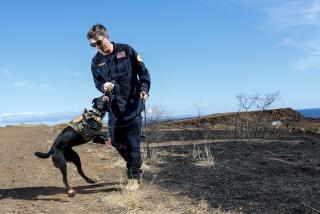Beagles have a nose for bedbugs
- Share via
There’s more than one way to bag a bedbug, or to sniff them out so the bagging can begin.
Matt and Matti of Huntington Beach -- beagles trained at the University of Florida Gainesville -- are two examples.
A beagle is a renowned aroma hound (although the Peanuts cartoon character Snoopy, “the world’s most famous beagle,” wasn’t best known for being olfactorial), and with education is able to catch a whiff of the sweet yet musty scent of a bedbug.
This is why Matt, Matti and their kind are valued at this time of bedbug overload. “Their sense of smell is absolutely amazing,” said Mike Masterson, owner of Isotech Pest Management Inc. in Pomona, which paid $20,000 for the two dogs and spends an additional $90,000 annually on their training, housing, food and other expenses.
They were members of the first Bedbug Detection Team certified under guidelines set this year by the National Entomology Scent Detection Canine Assn. in North Carolina, President Sam Smith said. Under these tougher requirements, dogs must learn how to identify live bedbugs or viable eggs.
“For a dog to tell you where dead bedbugs are,” Smith said, “is really useless.”
Early on, the association’s certifications went mostly to termite-detection dogs. Smith said bedbug hunters have recently taken the lead.
What’s next? Standards are being written for dogs that find bumble bees and, maybe, carpenter ants.
Matt and Matti aren’t low maintenance, said Kevin Alden, whose Covina company, K9 Bedbug Inspection Inc., sells smell-trained dogs. They need cuddles and kibbles and all kinds of reinforcement.
“They can be little juvenile delinquents some days. They wake up and say, ‘I don’t want to do this,’ ” Alden said, and need to be “loved up” a little. But on the job they’re no-nonsense.
“They start breathing really hard and they start getting very excited,” Alden said. “They’ll start perusing the whole room.”
If one of the pair perceives that bugs are hidden -- in a mattress, under the carpet or behind an electrical outlet -- the other is brought in for “validation.”
Beagles aren’t the only dogs that can learn to find live bedbugs. Smith said that an Australian kelpie and a Chinese crested terrier had been certified under the new guidelines. But Alden said beagles were the best. “Their nose goes to the ground,” he said, “and they’re very focused.”
--
(BEGIN TEXT OF INFOBOX)
Detecting bedbugs
If you notice a sweet, musty odor, it’s time to start looking.
Use a magnifying glass and a flashlight; bedbugs can be tiny and are nocturnal.
Look for brownish-red stains in likely hiding places, such as seams in mattresses and upholstered chairs; under baseboards and carpets; in clock radios, picture frames or telephones; within the folds of curtains and inside curtain rods.
What to do if you find them
Call a pest control specialist.
Don’t remove any items from the infested room before the exterminator shows up; you’ll just be helping the bugs migrate.
Label items for disposal as “bug infested” and wrap them in plastic.
Don’t blame yourself; infestations can happen to anyone.
Source: California Department of Health Services
More to Read
Sign up for Essential California
The most important California stories and recommendations in your inbox every morning.
You may occasionally receive promotional content from the Los Angeles Times.













